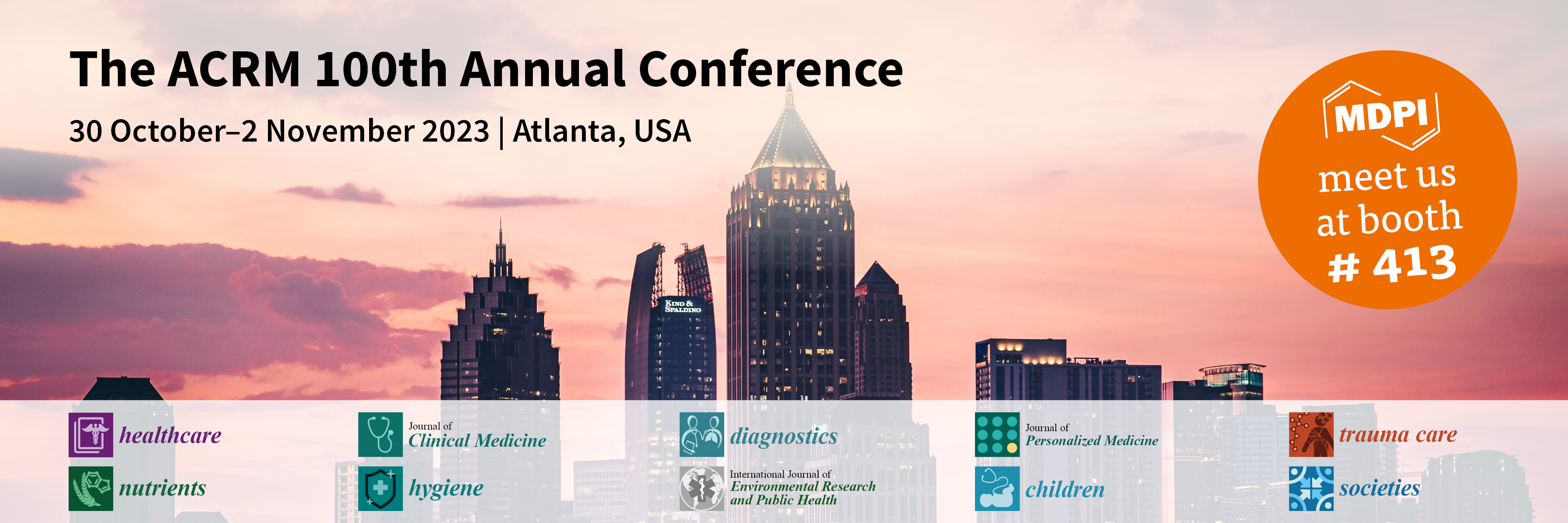Journal Description
Healthcare
Healthcare
is an international, scientific, peer-reviewed, open access journal on health care systems, industry, technology, policy, and regulation, and is published semimonthly online by MDPI. Ocular Wellness & Nutrition Society (OWNS) is affiliated with Healthcare and the members receive a discount on article processing charges.
- Open Access— free for readers, with article processing charges (APC) paid by authors or their institutions.
- High Visibility: indexed within Scopus, SCIE and SSCI (Web of Science), PubMed, PMC, and other databases.
- Journal Rank: JCR - Q2 (Health Policy & Services ) / CiteScore - Q2 (Leadership and Management)
- Rapid Publication: manuscripts are peer-reviewed and a first decision is provided to authors approximately 21.7 days after submission; acceptance to publication is undertaken in 2.6 days (median values for papers published in this journal in the first half of 2023).
- Recognition of Reviewers: reviewers who provide timely, thorough peer-review reports receive vouchers entitling them to a discount on the APC of their next publication in any MDPI journal, in appreciation of the work done.
Impact Factor:
2.8 (2022);
5-Year Impact Factor:
3.0 (2022)
Latest Articles
“Feeling Trapped in Prison” Due to the COVID-19 Pandemic: Perceptions and Practices among Healthcare Workers and Prison Staff from a Brazilian Maximum Security Unit
Healthcare 2023, 11(17), 2451; https://doi.org/10.3390/healthcare11172451 (registering DOI) - 01 Sep 2023
Abstract
The COVID-19 pandemic had several repercussions on prison staff, but the currently available evidence has mainly ignored these effects. This qualitative study aimed to understand the impact of COVID-19 on the prison system through the narratives of health and security professionals, using the
[...] Read more.
The COVID-19 pandemic had several repercussions on prison staff, but the currently available evidence has mainly ignored these effects. This qualitative study aimed to understand the impact of COVID-19 on the prison system through the narratives of health and security professionals, using the methodological framework of the constructivist grounded theory proposed by Charmaz. The sample included 10 healthcare workers and 10 security professionals. Data collection took place between October and November 2022 through individual in-depth interviews. The data were analyzed using the MaxQDA software. Three categories of interrelated data emerged: (1) “Confrontation and disruption” caused by the COVID-19 pandemic in the prison system; (2) “Between disinfodemic and solicitude” referring to the tension between information management and the practice of care centered on the needs of inmates; and, finally, (3) “Reorganization and mitigation strategies during the fight against COVID-19”. Continuous education and the development of specific skills are essential to enable professionals to face the challenges and complex demands that arise in prison contexts. The daily routines professionals had previously taken for granted were disrupted by COVID-19. Thus, investing in adequate training and emotional support programs is crucial to promote the resilience and well-being of these professionals, ensuring an efficient and quality response to critical events.
Full article
(This article belongs to the Special Issue Mental Health Promotion and Illness Prevention in Vulnerable Populations)
►
Show Figures
Open AccessArticle
General Practitioners’ Own Traumatic Experiences and Their Skills in Addressing Patients’ Past History of Adversities: A Cross-Sectional Study in Portugal
Healthcare 2023, 11(17), 2450; https://doi.org/10.3390/healthcare11172450 (registering DOI) - 01 Sep 2023
Abstract
Addressing trauma has been found to be important for primary care patients, as it can improve their health-related outcomes. We aimed to assess how Portuguese general practitioners’ (GPs) past history of traumatic events (TEs) and adverse childhood experiences (ACEs) influence their clinical communication
[...] Read more.
Addressing trauma has been found to be important for primary care patients, as it can improve their health-related outcomes. We aimed to assess how Portuguese general practitioners’ (GPs) past history of traumatic events (TEs) and adverse childhood experiences (ACEs) influence their clinical communication skills when addressing their patients’ past history of adversities. An online survey was circulated by email to GPs’ associations and through GPs’ social media groups. A sample of 143 GPs participated in this study. GPs’ exposure to ACEs and TEs was assessed using the Childhood Trauma Questionnaire-Short Form and the Life Events Checklist for the DSM-5. To evaluate clinical communication skills, we adapted the Self-confidence Scale and used the Jefferson Scale of Physician Empathy. GPs identified barriers to addressing trauma routinely, including a lack of time (86.7%) and a fear of causing further patient suffering (56.6%). GPs’ exposure to TEs and ACEs was positively correlated with scores in some dimensions of self-confidence and empathy (r values varying from 0.170 to 0.247). GPs exposed to traumatic experiences felt more confident when addressing their patients’ adversities and were more empathic when conducting therapeutic relationships. This study shows that GPs with a history of traumatic experiences are able to address their patients’ adversities; however, they lack proper training and better patient care conditions, such as more time and more resources available for patient guidance.
Full article
(This article belongs to the Section Family Medicine)
Open AccessReview
Effectiveness of a Standardized Nursing Process Using NANDA International, Nursing Interventions Classification and Nursing Outcome Classification Terminologies: A Systematic Review
by
, , , , and
Healthcare 2023, 11(17), 2449; https://doi.org/10.3390/healthcare11172449 (registering DOI) - 01 Sep 2023
Abstract
The decision-making in clinical nursing, regarding diagnoses, interventions and outcomes, can be assessed using standardized language systems such as NANDA International, the Nursing Interventions Classification and the Nursing Outcome Classification; these taxonomies are the most commonly used by nurses in informatized clinical records.
[...] Read more.
The decision-making in clinical nursing, regarding diagnoses, interventions and outcomes, can be assessed using standardized language systems such as NANDA International, the Nursing Interventions Classification and the Nursing Outcome Classification; these taxonomies are the most commonly used by nurses in informatized clinical records. The purpose of this review is to synthesize the evidence on the effectiveness of the nursing process with standardized terminology using the NANDA International, the Nursing Interventions Classification and the Nursing Outcome Classification in care practice to assess the association between the presence of the related/risk factors and the clinical decision-making about nursing diagnosis, assessing the effectiveness of nursing interventions and health outcomes, and increasing people’s satisfaction. A systematic review was carried out in Medline and PreMedline (OvidSP), Embase (Embase-Elsevier), The Cochrane Library (Wiley), CINAHL (EbscoHOST), SCI-EXPANDED, SSCI and Scielo (WOS), LILACS (Health Virtual Library) and SCOPUS (SCOPUS-Elsevier) and included randomized clinical trials as well as quasi-experimental, cohort and case-control studies. Selection and critical appraisal were conducted by two independent reviewers. The certainty of the evidence was assessed with the Grading of Recommendations Assessment, Development and Evaluation Methodology. A total of 17 studies were included with variability in the level and certainty of evidence. According to the outcomes, 6 studies assessed diagnostic decision-making and 11 assessed improvements in individual health outcomes. No studies assessed improvements in intervention effectiveness or population satisfaction. There is a need to increase studies with rigorous methodologies that address clinical decision-making about nursing diagnoses using NANDA International and individuals’ health outcomes using the Nursing Interventions Classification and the Nursing Outcome Classification as well as implementing studies that assess the use of these terminologies for improvements in the effectiveness of nurses’ interventions and population satisfaction with the nursing process.
Full article
(This article belongs to the Special Issue Clinical Nursing in Healthcare)
►▼
Show Figures
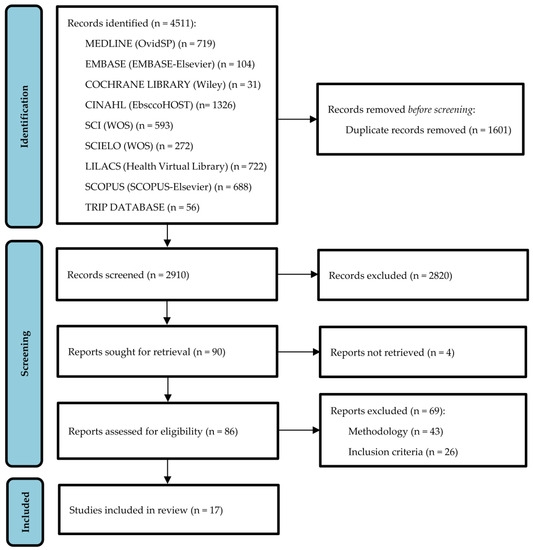
Figure 1
Open AccessArticle
A Retrospective Analysis of Familicide in Latium (Italy): A Criminological Profile of the Victims and Offenders Involved in 29 Cases and a Comparison with the Literature
by
, , , , , , , and
Healthcare 2023, 11(17), 2448; https://doi.org/10.3390/healthcare11172448 (registering DOI) - 01 Sep 2023
Abstract
Familicide, an extreme form of domestic violence where one family member kills another, is a complex criminological issue. We analyzed autopsy files from the Institute of Legal Medicine, University of Rome Tor Vergata (1995–2022), to understand familicide better. The study focused on victim
[...] Read more.
Familicide, an extreme form of domestic violence where one family member kills another, is a complex criminological issue. We analyzed autopsy files from the Institute of Legal Medicine, University of Rome Tor Vergata (1995–2022), to understand familicide better. The study focused on victim profiles, offender characteristics, and case dynamics. From 29 analyzed cases, 31 victims emerged, with 2 instances of double homicide. The perpetrators were mostly male (79.31%) and the victims were primarily female (54.84%). The familial ties ranged from parent–child to siblings and spouses. A significant number of crimes happened at private residences (70.97%) using bladed weapons (48.39%), with the injuries being concentrated on the head and chest. Half of the cases showed struggle signs, and 24.14% of the perpetrators had identifiable psychiatric disorders, which often served as the motive. Post-crime actions included self-reporting, suicide attempts, and successful suicides. A comparison with literature confirmed the typical familicide offender as a middle-aged male with potential social stressors and a history of domestic violence, with the victims often being female family members. Mental health conditions including depression, bipolar disorder, and schizophrenia significantly impacted these events. These findings underline the need for customized approaches to comprehending and preventing familicide.
Full article
(This article belongs to the Special Issue Forensic and Legal Medicine in the Third Millennium)
Open AccessArticle
Activities of Clinical Expertise and Research in a Rare Disease Referral Centre: A Place for Telemedicine beyond the COVID-19 Pandemic?
by
, , , , , , , , , , , , and
Healthcare 2023, 11(17), 2447; https://doi.org/10.3390/healthcare11172447 - 31 Aug 2023
Abstract
Introduction: Rare disease referral centres are entrusted with missions of clinical expertise and research, two activities that have to contend with numerous obstacles. Providing specialist opinions is time-consuming, uncompensated and limited by difficulties in exchanging medical data. Clinical research is constrained by the
[...] Read more.
Introduction: Rare disease referral centres are entrusted with missions of clinical expertise and research, two activities that have to contend with numerous obstacles. Providing specialist opinions is time-consuming, uncompensated and limited by difficulties in exchanging medical data. Clinical research is constrained by the need for frequent research protocol visits. Our objective was to determine whether telemedicine (TLM) can overcome these difficulties. Methods: To better characterise the activity of clinical expertise provided by our French centre, each opinion delivered by our team was reported on a standardised form. To investigate our clinical research activity, investigators and patients were asked to complete a questionnaire on the acceptability of research protocol teleconsultations. Results: Regarding clinical expertise, our team delivered 120 opinions per week (representing a total of 21 h), of which 29% were delivered to patients and 69% to medical practitioners. If these were delivered using TLM, it would represent a potential weekly income of EUR 500 (tele-expertise) and EUR 775 (teleconsultations). Regarding the research activity, 70% of investigators considered the frequency of visits to be a limiting factor for patient inclusions; nearly half of the patients surveyed would be in favour of having teleconsultations in place of (40%) or in addition to (56%) in-person visits. Conclusion: Whereas TLM has become widely used as a back-up procedure to in-person consultations during the COVID-19 pandemic, the solutions it provides to the problems encountered in performing expertise and research activities have made it a new conventional follow-up modality for patients with rare diseases.
Full article
(This article belongs to the Section Health Assessments)
►▼
Show Figures
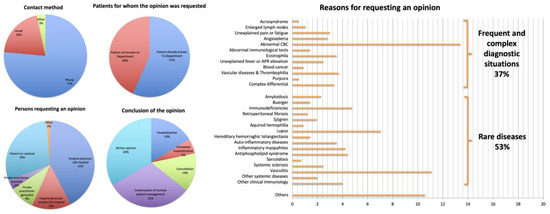
Figure 1
Open AccessReview
Neuropsychology of Generalized Anxiety Disorder in Clinical Setting: A Systematic Evaluation
Healthcare 2023, 11(17), 2446; https://doi.org/10.3390/healthcare11172446 - 31 Aug 2023
Abstract
This research paper provides a systematic review of the neuropsychology of generalized anxiety disorder (GAD), examining relevant articles’ methodologies and subject matter and highlighting key findings. It suggests potential cognitive deficits in GAD patients, such as subtle attention, executive function, and working memory
[...] Read more.
This research paper provides a systematic review of the neuropsychology of generalized anxiety disorder (GAD), examining relevant articles’ methodologies and subject matter and highlighting key findings. It suggests potential cognitive deficits in GAD patients, such as subtle attention, executive function, and working memory deficiencies. It also discusses neural correlates of GAD, particularly the hyperactivity in the amygdala and insula, and the additional impact of comorbidity with other psychiatric disorders. The paper uses the PRISMA methodology and draws data from the PsycINFO, Scopus, PubMed, and Elsevier databases. Although the reviewed research has contributed to understanding GAD’s cognitive and neural mechanisms, further research is required. Additionally, the paper mentions the clinical neuropsychology of GAD, including strategies and treatments, such as cognitive behavioral therapy (CBT), mindfulness, and medication. Lastly, the review identifies the limitations of the existing research and recommends future directions to enhance the understanding of GAD’s underlying cognitive and neural mechanisms. The neural underpinnings of GAD encompass heightened activity within the amygdala and insula, which are brain regions implicated in processing adverse emotional reactions. Co-occurring psychiatric disorders, such as major depressive disorder (MDD), can also impact neuropsychological functioning. Additional investigation is warranted to better understand the intricate interplay between GAD, cognitive performance, and underlying neural processes.
Full article
(This article belongs to the Special Issue Primary and Community Care: Opportunities and Challenges)
►▼
Show Figures
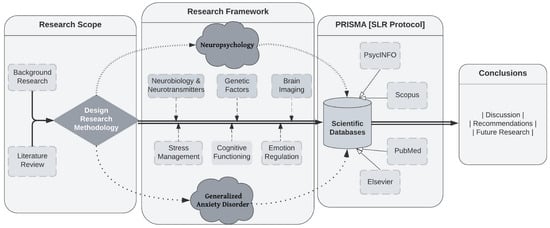
Figure 1
Open AccessArticle
Youth Dating Violence, Behavioral Sensitivity, and Emotional Intelligence: A Mediation Analysis
Healthcare 2023, 11(17), 2445; https://doi.org/10.3390/healthcare11172445 - 31 Aug 2023
Abstract
Intimate partner violence is a multidimensional phenomenon encompassing psychological, physical, and sexual components. Violence in young couples is common in our society. This kind of violence is usually bidirectional, which adds to its complexity. This study aimed to explore how victimization (in three
[...] Read more.
Intimate partner violence is a multidimensional phenomenon encompassing psychological, physical, and sexual components. Violence in young couples is common in our society. This kind of violence is usually bidirectional, which adds to its complexity. This study aimed to explore how victimization (in three dimensions: non-abuse, technical mistreatment, and mistreatment) and perpetration (in two dimensions: non-perpetrator and perpetrator) are related to the BIS (Behavioral Inhibition System)/BAS (Behavioral Approach System), and it also evaluated if the dimensions of emotional intelligence (EI) (emotional attention, clarity, and regulation) mediate this relationship. Violence was evaluated in 272 young volunteer participants, as well as BIS/BAS behavioral sensitivity and perceived emotional intelligence. The correlations between these variables were analyzed, and a mediation analysis was also conducted. The results show that victimization (of the sexual and coercive type) was associated with less BAS activation, while victimization (of the sexual, humiliation, and detachment types) was associated with less BIS activity. All types of victimization were associated with less EI, specifically with less emotional clarity. Aggression (of the sexual, humiliation, detachment, and coercion types) was related to lower BAS and higher BIS sensitivity. Detachment aggression was associated with low emotional clarity. In conclusion, relationships between victimization and perpetration are evidenced in terms of BIS/BAS sensitivity and EI. Specifically, the dimension of EI emotional clarity acts as a mediator of BIS activation in victims of detachment.
Full article
(This article belongs to the Special Issue Intimate Partner Violence: Risk and Vulnerability Factors, Health Promotion and Prevention in Educational and Healthcare Contexts)
►▼
Show Figures

Figure 1
Open AccessArticle
Pharmacists’ Perceptions of Physician–Pharmacist Collaboration—A 2022 Cross-Sectional Survey in Poland
Healthcare 2023, 11(17), 2444; https://doi.org/10.3390/healthcare11172444 - 31 Aug 2023
Abstract
Patient-centered care requires close collaboration among multiple healthcare professionals, including physician–pharmacist collaboration (especially as a part of pharmaceutical care). This study aimed to assess pharmacists’ perceptions of physician–pharmacist collaboration as well as to identify factors associated with the willingness to provide pharmaceutical care
[...] Read more.
Patient-centered care requires close collaboration among multiple healthcare professionals, including physician–pharmacist collaboration (especially as a part of pharmaceutical care). This study aimed to assess pharmacists’ perceptions of physician–pharmacist collaboration as well as to identify factors associated with the willingness to provide pharmaceutical care services in Poland. This questionnaire-based survey was carried out in 2022 among community pharmacists from one of the largest franchise chain pharmacy networks in Poland. Completed questionnaires were received from 635 community pharmacists (response rate of 47.9%). Almost all the pharmacists agreed with the statement that there is a need for physician–pharmacist collaboration (98.2%), and 94.8% declared that pharmacists can help physicians in patient care and pharmacotherapy. Most pharmacists (80%) believed that physicians were not aware of the competencies of pharmacists resulting from Polish law. Patient education (89.9%), detection of polypharmacy (88%), and detection of interactions between drugs and dietary supplements (85.7%) were the most common tasks in the field of pharmaceutical care that can be provided by a pharmacist. Females were more likely (p < 0.05) to declare the need for physician–pharmacist collaboration. Age and location of the pharmacy were the most important factors (p < 0.05) associated with pharmacists’ attitudes toward physician–pharmacist collaboration.
Full article
Open AccessArticle
The Effects of Combining Aerobic and Heavy Resistance Training on Body Composition, Muscle Hypertrophy, and Exercise Satisfaction in Physically Active Adults
by
, , , , , and
Healthcare 2023, 11(17), 2443; https://doi.org/10.3390/healthcare11172443 - 31 Aug 2023
Abstract
This study investigated the effects of combined aerobic and heavy resistance training on the variables of body composition, muscle hypertrophy, and exercise satisfaction in physically active adults in comparison with heavy resistance training only (predominantly designed for hypertrophy). Twenty-two healthy male adults between
[...] Read more.
This study investigated the effects of combined aerobic and heavy resistance training on the variables of body composition, muscle hypertrophy, and exercise satisfaction in physically active adults in comparison with heavy resistance training only (predominantly designed for hypertrophy). Twenty-two healthy male adults between the ages of 18 and 35, who had limited previous experience with muscle resistance training, participated in the intervention program while maintaining their physical activity level. The participants were randomly allocated into two groups: the resistance training group (control group) and the combined training group (experimental group), which involved both resistance training and aerobic training. Aerobic training consisted of 30 min aerobic interval training sessions three times a week with a total of 8 min work bouts in each at 60–70% of heart rate reserve (HRR). The intervention training program lasted for eight weeks. Resistance training consisted of a 3-day muscle group split (2–3 exercises per muscle group, 8 sets per muscle group, 6–12 repetition maximum (RM). Upon completion, body composition, muscle hypertrophy, and exercise satisfaction were analyzed using the mixed-design ANOVA. Variables selected for this study as markers of body composition responded differently to the different interventions and time; however, some trends were not statistically significant. Overall, it is not possible to state unequivocally that one training modality was superior to another in the body composition cluster, for significant improvements were observed within the groups from pre- to post-interventions, but no significant differences were observed between the resistance training and combined training groups, while, both interventions showed improvement with time in some variables of muscle hypertrophy. Compared to baseline, the exercise satisfaction post-intervention improved within the groups. From pre- to post-testing, both resistance and combined training groups improved exercise satisfaction (p < 0.05 in both groups). However, there was no significant difference in exercise satisfaction observed between the resistance training and combined training groups after the training intervention (p > 0.05).
Full article
(This article belongs to the Special Issue Exercise Testing and Prescription Strategies to Improve Quality of Life)
►▼
Show Figures
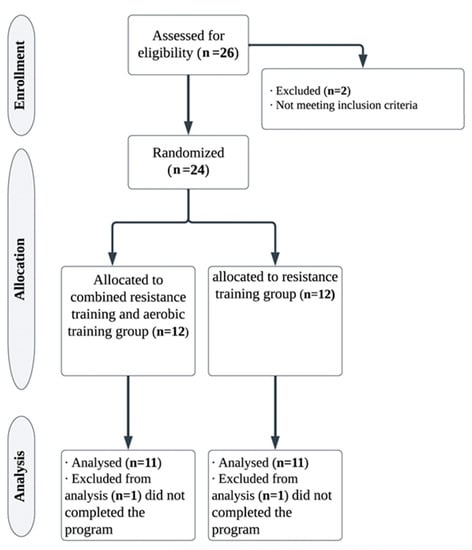
Figure 1
Open AccessSystematic Review
Effectiveness of Osteopathic Manipulative Treatment in Adults with Irritable Bowel Syndrome: A Systematic Review and Meta-Analysis
by
, , , , , , and
Healthcare 2023, 11(17), 2442; https://doi.org/10.3390/healthcare11172442 - 31 Aug 2023
Abstract
The aim of this systematic review and meta-analysis was to evaluate the effectiveness of the osteopathic manipulative treatment (OMT) in adults with irritable bowel syndrome (IBS). A literature resview was carried out on the following databases: PubMed, Embase, Cochrane, Cinahl, Scopus, PEDro and
[...] Read more.
The aim of this systematic review and meta-analysis was to evaluate the effectiveness of the osteopathic manipulative treatment (OMT) in adults with irritable bowel syndrome (IBS). A literature resview was carried out on the following databases: PubMed, Embase, Cochrane, Cinahl, Scopus, PEDro and ClinicalTrials.gov. 350 articles were recovered. Eligibility criteria were evaluated by two independent reviewers, including randomized controlled trials (RCTs), quasi-RCTs, or ongoing RCTs with OMT compared to any kind of control in patients diagnosed with IBS. Six studies (five RCTs and one ongoing RCT) were considered eligible. Four RCTs were classified as some concerns and one as high risk of bias. In the meta-analysis, OMT compared to sham/no intervention showed statistically significant results for abdominal pain (effect size ES = −1.14 [−1.66, −0.62]; p < 0.0001) and constipation (ES = −0.66 [−1.12, −0.20]; p = 0.005). Instead, OMT was not superior to the control for the IBS symptoms measured with the IBS Severity Score and the Likert scale (ES = −0.34 [−0.83, 0.16]; p = 0.19), and diarrhea (ES = −1.20 [−2.84, 0.43]; p = 0.15). The quality of evidence was “low” for IBS symptoms in general for abdominal pain and constipation, while it was judged as “very low” for diarrhea. OMT turns out to be safe in the treatment of IBS without major adverse effects. OMT may be effective in IBS patients, however the results must be interpreted carefully due to the low methodological quality of the studies.
Full article
(This article belongs to the Collection Osteopathic and Manual Therapy Healthcare Reconceptualization: Health Needs and New Evidence)
►▼
Show Figures
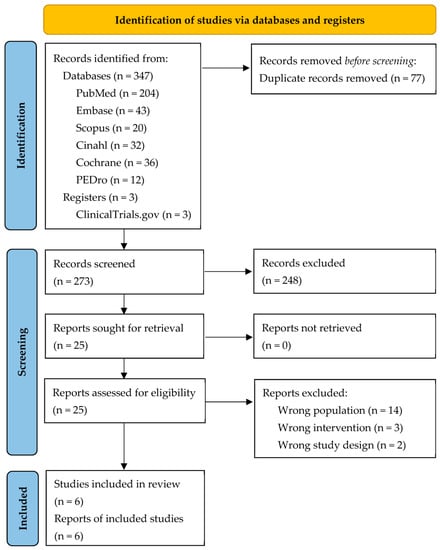
Figure 1
Open AccessCase Report
Assessment of the Extent of Intracerebral Hemorrhage Using 3D Modeling Technology
Healthcare 2023, 11(17), 2441; https://doi.org/10.3390/healthcare11172441 - 31 Aug 2023
Abstract
►▼
Show Figures
The second most common cause of stroke, accounting for 10% of hospital admissions, is intracerebral hemorrhage (ICH), and risk factors include diabetes, smoking, and hypertension. People with intracerebral bleeding experience symptoms that are related to the functions that are managed by the affected
[...] Read more.
The second most common cause of stroke, accounting for 10% of hospital admissions, is intracerebral hemorrhage (ICH), and risk factors include diabetes, smoking, and hypertension. People with intracerebral bleeding experience symptoms that are related to the functions that are managed by the affected part of the brain. Having obtained 15 computed tomography (CT) scans from five patients with ICH, we decided to use three-dimensional (3D) modeling technology to estimate the bleeding volume. CT was performed on admission to hospital, and after one week and two weeks of treatment. We segmented the brain, ventricles, and hemorrhage using semi-automatic algorithms in Slicer 3D, then improved the obtained models in Blender. Moreover, the accuracy of the models was checked by comparing corresponding CT scans with 3D brain model cross-sections. The goal of the research was to examine the possibility of using 3D modeling technology to visualize intracerebral hemorrhage and assess its treatment.
Full article

Figure 1
Open AccessArticle
Long-Term Adoption or Abandonment of Smart Technology in the Chinese Elderly Home Care Environment: A Qualitative Research Study
Healthcare 2023, 11(17), 2440; https://doi.org/10.3390/healthcare11172440 - 31 Aug 2023
Abstract
China’s rapidly aging population and shortage of care resources have made it difficult for its traditional model to meet the home care needs of the elderly. On this premise, China is implementing home digital health interventions based on smart technology. During implementation, instead
[...] Read more.
China’s rapidly aging population and shortage of care resources have made it difficult for its traditional model to meet the home care needs of the elderly. On this premise, China is implementing home digital health interventions based on smart technology. During implementation, instead of the expected explosion in long-term adoption, there has been a large amount of abandonment. But so far, the relationship between service experience and these behaviors has been ignored. This study aims to explore the reasons for the long-term adoption or abandonment behaviors of technology by elders in the home care environment. A qualitative study was conducted based on Golant’s framework of smart technology adoption behaviors among elders. Semi-structured interviews were conducted with 26 elders who are long-term or former users of smart technology in a home care environment, and data from the interviews were analyzed using directed content analysis. This study identified three themes that influence elders’ adoption behaviors of smart technology in the home care environment, including immediate effectiveness, long-term usability, and possible collateral damage. The findings indicated that the experience of the elders is the key point that affects long-term adoption behavior. For more elders to use smart technology in the home care environment, it is necessary for the government, technology developers, and nursing institutions to further reform the existing system.
Full article
Open AccessArticle
When Unstructured Big Text Corpus Meets Text Network Analysis: Social Reality Conceptualization and Visualization Graph of Big Interview Data of Heavy Drug Addicts of Skid Row
by
and
Healthcare 2023, 11(17), 2439; https://doi.org/10.3390/healthcare11172439 - 31 Aug 2023
Abstract
Relying on user-generated content narrating individual experiences and personalized contextualization of location-specific realities, this study introduced a novel methodological approach and analysis tool that can aid health informatics in understanding the social reality of people with a substance-use disorder in Skid Row, Los
[...] Read more.
Relying on user-generated content narrating individual experiences and personalized contextualization of location-specific realities, this study introduced a novel methodological approach and analysis tool that can aid health informatics in understanding the social reality of people with a substance-use disorder in Skid Row, Los Angeles. The study also highlighted analysis possibilities for big unstructured interview text corpus using InfraNodus, a text network analysis tool. InfraNodus, which is a text graph analysis tool, identifies pathways for meaning circulation within unstructured interview data and has the potential to classify topical clusters and generate contextualized analysis results for big narrative textual datasets. Using InfraNodus, we analyzed a 1,103,528-word unstructured interview transcript from 315 interview sessions with people with a substance-use disorder, who narrated their respective social realities. Challenging the overgeneralization of onlookers, the conceptualization process identified topical clusters and pathways for meaning circulation within the narrative data, generating unbiased contextualized meaning for the collective social reality. Our endeavors in this research, along with our methodological setting and selection, might contribute to the methodological efforts of health informatics or the conceptualization and visualization needs of any big text corpus.
Full article
(This article belongs to the Special Issue Analysis of Healthcare Big Data and Health Informatics)
►▼
Show Figures
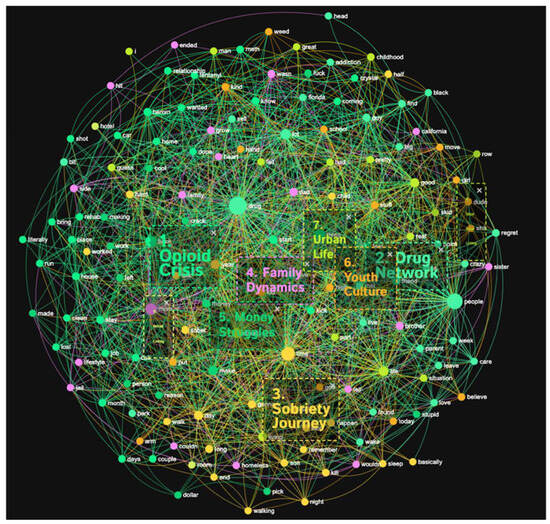
Figure 1
Open AccessArticle
Healthcare Professionals’ Attitudes towards and Knowledge and Understanding of Paediatric Palliative Medicine (PPM) and Its Meaning within the Paediatric Intensive Care Unit (PICU): A Summative Content Analysis in a Tertiary Children’s Hospital in Scotland—“An In Vitro Study”
Healthcare 2023, 11(17), 2438; https://doi.org/10.3390/healthcare11172438 - 31 Aug 2023
Abstract
Background: Paediatric palliative medicine (PPM) is a holistic approach to care for children and their families. Services are growing and developing worldwide but significant disparity in service provision remains. The Paediatric Supportive and Palliative Care Team (PSPCT) at the Royal Hospital for Children
[...] Read more.
Background: Paediatric palliative medicine (PPM) is a holistic approach to care for children and their families. Services are growing and developing worldwide but significant disparity in service provision remains. The Paediatric Supportive and Palliative Care Team (PSPCT) at the Royal Hospital for Children in Glasgow was established in 2019, but there is still no clear integrated role within the paediatric intensive care unit (PICU) at present. Through analysing the attitudes, meaning, knowledge and understanding of PPM in the PICU environment, we hoped to explore the experiences of those providing paediatric palliative care and to identify any barriers to or facilitators of integrated working to gain a better understanding of providing this care. Methods: This qualitative study used a survey composed of five open-ended and five closed questions. Sixteen out of a possible thirty-two responses (50%) were accrued from PICU healthcare professionals, including consultants (n = 19), advanced nurse practitioners (n = 4) and band-seven nurses (n = 9). The data were comprehensively studied and analysed by two coders using summative content analysis with assistance from data management software. Codes were further developed to form categories and subcategories. Results: Two categories were found: (1) the role of palliative care and (2) experiences of providing palliative care. A total of five subcategories were found, demonstrating that the PSPCT can enhance care in PICU through collaborative working. Barriers identified included staffing, funding and stigma around palliative care. Conclusions: This study shows that PICU professionals have a good understanding of the concepts of PPM and view it as an essential part of PICU work. Barriers related to resources and misperceptions of palliative care can be overcome through improved education, funding and staff retention, but this would require buy-in from policymakers. The perspective from our relatively small team increases generalizability to growing teams across the country.
Full article
(This article belongs to the Special Issue Advances in Pediatric Palliative Care)
Open AccessArticle
Improvement of Predictive Scores in Burn Medicine through Different Machine Learning Approaches
by
, , , , , , , , , , and
Healthcare 2023, 11(17), 2437; https://doi.org/10.3390/healthcare11172437 - 31 Aug 2023
Abstract
The mortality of severely burned patients can be predicted by multiple scores which have been created over the last decades. As the treatment of burn injuries and intensive care management have improved immensely over the last years, former prediction scores seem to be
[...] Read more.
The mortality of severely burned patients can be predicted by multiple scores which have been created over the last decades. As the treatment of burn injuries and intensive care management have improved immensely over the last years, former prediction scores seem to be losing accuracy in predicting survival. Therefore, various modifications of existing scores have been established and innovative scores have been introduced. In this study, we used data from the German Burn Registry and analyzed them regarding patient mortality using different methods of machine learning. We used Classification and Regression Trees (CARTs), random forests, XGBoost, and logistic regression regarding predictive features for patient mortality. Analyzing the data of 1401 patients via machine learning, the factors of full-thickness burns, patient’s age, and total burned surface area could be identified as the most important features regarding the prediction of patient mortality following burn trauma. Although the different methods identified similar aspects, application of machine learning shows that more data are necessary for a valid analysis. In the future, the usage of machine learning can contribute to the development of an innovative and precise predictive score in burn medicine and even to further interpretations of relevant data regarding different forms of outcome from the German Burn registry.
Full article
(This article belongs to the Special Issue Perspectives on Plastic, Reconstructive and Hand Surgery)
►▼
Show Figures
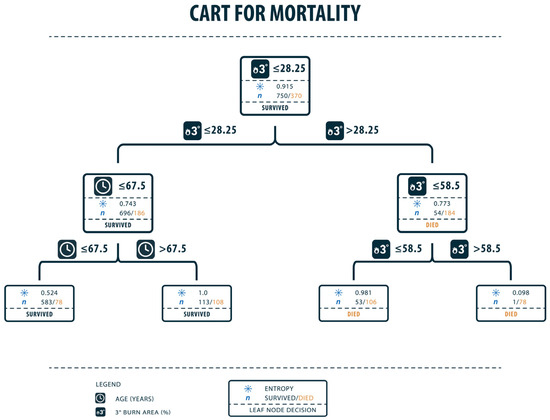
Figure 1
Open AccessArticle
Evaluating Changes in Trauma Epidemiology during the COVID-19 Lockdown: Insights and Implications for Public Health and Disaster Preparedness
by
, , , , , , , , , and
Healthcare 2023, 11(17), 2436; https://doi.org/10.3390/healthcare11172436 - 31 Aug 2023
Abstract
The COVID-19 pandemic demanded changes in healthcare systems worldwide. The lockdown brought about difficulties in healthcare access. However, trauma still required further attention considering its modifications. The presented study aims to investigate the variances in epidemiological patterns of trauma during the lockdown and
[...] Read more.
The COVID-19 pandemic demanded changes in healthcare systems worldwide. The lockdown brought about difficulties in healthcare access. However, trauma still required further attention considering its modifications. The presented study aims to investigate the variances in epidemiological patterns of trauma during the lockdown and the previous year, with a view to better understand the modifications in healthcare provision. The authors analyzed data from the first lockdown in 2020 (12 March–30 May) and the same period in 2019 from 35 hospitals in Lublin Province. A total of 10,806 patients in 2019 and 5212 patients in 2020 were included in the research. The uncovered changes adhered to the total admissions and mortality rate, the frequency of injuries in particular body regions, and injury mechanisms. The lockdown period resulted in a reduction in trauma, requiring an altered approach to healthcare provision. Our research indicates that the altered approach facilitated during such periods is essential for delivering tailored help to trauma patients.
Full article
(This article belongs to the Special Issue Current and Future Challenges in Public Health and Disaster Preparedness)
►▼
Show Figures
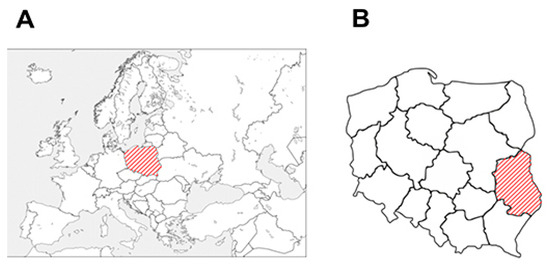
Figure 1
Open AccessArticle
The Influence of Perceived Security in Childhood on Adult Self-Concept: The Mediating Role of Resilience and Self-Esteem
Healthcare 2023, 11(17), 2435; https://doi.org/10.3390/healthcare11172435 - 31 Aug 2023
Abstract
Secure attachment, developed through consistent relationships with attachment figures in childhood, is a crucial factor in fostering healthy interpersonal relationships and a positive self-perception. Part of the positive parenting approach and the theory of affect is taken as a basis to assess how
[...] Read more.
Secure attachment, developed through consistent relationships with attachment figures in childhood, is a crucial factor in fostering healthy interpersonal relationships and a positive self-perception. Part of the positive parenting approach and the theory of affect is taken as a basis to assess how perceived security, as an indicator of secure attachment, predicts adult self-concept through the mediating effects of resilience and positive self-esteem. A quantitative, cross-sectional, and nonprobabilistic study was conducted with 383 participants. We unveiled significant positive associations between perceived security, self-concept, resilience, and positive self-esteem. Path analysis demonstrated that resilience and positive self-esteem sequentially mediate the relationship between perceived security during childhood and adult self-concept. Findings suggest that the ability to cope with adversity and personal acceptance underlie the impact of perceived security on self-concept. It is recommended to promote family intervention programs framed within positive parenting that focus on fostering secure attachment given its influence on adult life. It is also deemed essential to incorporate the promotion of resilience and self-esteem into programs aimed at youths, and adult role models can enhance their self-perception and resilience in the face of potential effects stemming from insecure parenting practices.
Full article
(This article belongs to the Special Issue New Challenges for Research in Family Relationships and Child Well-Being)
►▼
Show Figures
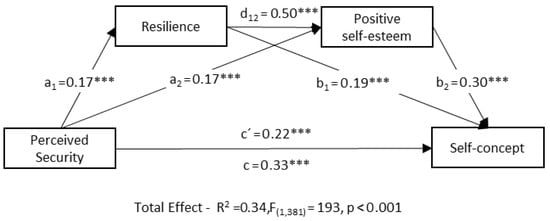
Figure 1
Open AccessReview
The Role of the Nurse in the Care and Management of Patients with Rheumatic Diseases Arising from the Current EULAR Recommendations: A Literature Review
Healthcare 2023, 11(17), 2434; https://doi.org/10.3390/healthcare11172434 - 31 Aug 2023
Abstract
►▼
Show Figures
In some countries, restructuring of the healthcare system has contributed to the introduction of a new domain in professional nursing—the Advanced Practice Nurse (APN). In order to provide the highest quality of care to patients, nurses working at the advanced level are expected
[...] Read more.
In some countries, restructuring of the healthcare system has contributed to the introduction of a new domain in professional nursing—the Advanced Practice Nurse (APN). In order to provide the highest quality of care to patients, nurses working at the advanced level are expected to develop knowledge and to initiate services and practices carried out in collaboration with other professionals. In 2018, the European League Against Rheumatism (EULAR) updated its recommendations for the role of the nurse in the management and care of patients with rheumatic conditions. The objective of the study was a presentation of the scope of medical services provided by nurses for patients with rheumatic diseases based on current EULAR recommendations. A review of the literature on the participation of nurses, as members of a multidisciplinary team, in the education, management, psychosocial support, and promotion of self-care in patients with rheumatic diseases was presented. The expert group formulated three overarching principles and eight recommendations. The literature review and expert recommendations indicated that nurses’ tasks in relation to patients with rheumatic diseases should include an initial assessment of health needs, routine follow-up care, and counseling for patients on self-care and lifestyle changes. In the EULAR recommendations, nursing care is also defined as a practice model in which nurses, in collaboration with physicians, provide support, education, and disease monitoring to patients with rheumatic conditions. The requirement for extended nursing education at the advanced practice level, aimed at acquiring diagnostic, therapeutic, caring, and educational knowledge and skills was highlighted, particularly with regard to the EULAR recommendations.
Full article
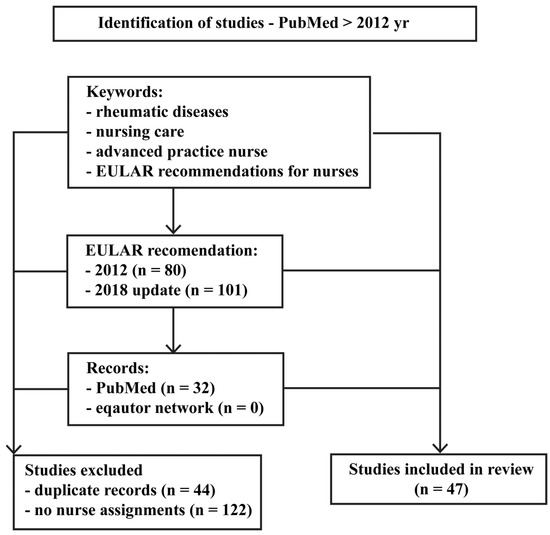
Figure 1
Open AccessArticle
Correlation between Parental Hostility and Child Self-Control and Aggression
by
and
Healthcare 2023, 11(17), 2433; https://doi.org/10.3390/healthcare11172433 - 31 Aug 2023
Abstract
(1) Background: Child aggression is not easily reduced as children grow up, and it is a serious problem that can develop into a life of crime if left unaddressed. (2) Methods: This study was conducted among elementary school children and their parents in
[...] Read more.
(1) Background: Child aggression is not easily reduced as children grow up, and it is a serious problem that can develop into a life of crime if left unaddressed. (2) Methods: This study was conducted among elementary school children and their parents in C and K provinces and D city. Data were collected through a survey. Pearson’s correlation coefficient was used to analyze parental hostility and each child’s self-control and aggression. (3) Results: Child aggression had a significant negative correlation with self-control and a significant positive correlation with parental hostility. In particular, there was a significant positive correlation between physical aggression and revenge, which are sub-factors of parental hostility. In addition, the children’s self-control was significantly negatively correlated with parental hostility. (4) Conclusions: Since there is a positive correlation between children’s aggression and self-control, it is necessary to develop strategies to improve self-control when seeking intervention measures for children’s aggression. In addition, since there is a significant quantitative correlation between children’s aggression and parental hostility, it is necessary to deal with parental hostility in order to control children’s aggression. Since there is a significant negative correlation between parental hostility and children’s self-control, it is necessary to emphasize the importance of parental attitudes and behaviors to improve children’s self-control.
Full article
(This article belongs to the Section Nursing)
Open AccessReview
The Use of Alternative Rooms in Forensic and Regular Psychiatric Units: A Scoping Review
by
, , , and
Healthcare 2023, 11(17), 2432; https://doi.org/10.3390/healthcare11172432 - 31 Aug 2023
Abstract
►▼
Show Figures
(1) Background: Emotional regulation, distress and relational conflicts often occur during hospitalization and rehabilitation on psychiatric units, especially in patients suffering from severe and persistent mental disorders. While widely used in children and geriatric patients, little literature exists on the use and outcomes
[...] Read more.
(1) Background: Emotional regulation, distress and relational conflicts often occur during hospitalization and rehabilitation on psychiatric units, especially in patients suffering from severe and persistent mental disorders. While widely used in children and geriatric patients, little literature exists on the use and outcomes of alternative rooms in the context of forensic and regular psychiatric units for adult patients. Considering the scarcity of the literature on alternative use, this study is motivated by the following research question: what are the main uses and outcomes of alternative rooms in the context of forensic and regular psychiatric units? The main objective of this study is to conduct a scoping review of the use and outcomes of alternative rooms for the context of psychiatric inpatients. (2) Methods: A systematic search was performed in the electronic databases of MedLine, Web of Science, PsycNet (PsycINFO) and Google Scholar from their inception dates until 2022. (3) Results: A total of nine studies were analyzed. Sensory, multisensory rooms, Snoezelen, and comfort rooms are the types of alternative rooms discussed in these studies. Distress and anxiety reduction, increase in self-esteem, impact on seclusion rates, patient–staff communication and alliances, heart and respiration rate reduction, and improvement of alexithymia were identified among the main uses and outcomes of these rooms. (4) Conclusions: The scarcity of literature available to draw information from for this review and possible impact on improving patient outcomes and quality of treatment in psychiatric units opens the door to future studies to better understand the efficacy of such rooms. Research into the ideal implementation tactics of such rooms, long-term outcomes, and the influence on diverse patient demographics could be areas of improvement in the use of alternative rooms.
Full article
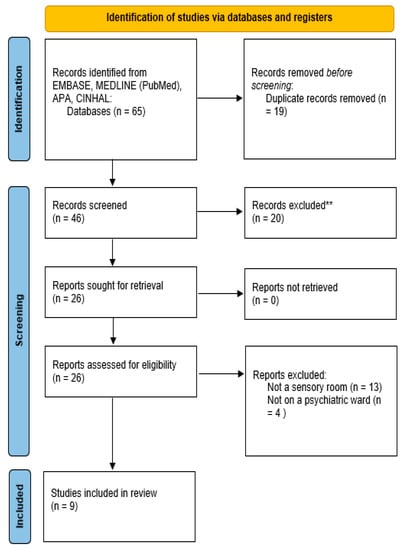
Figure 1

Journal Menu
► ▼ Journal Menu-
- Healthcare Home
- Aims & Scope
- Editorial Board
- Reviewer Board
- Topical Advisory Panel
- Instructions for Authors
- Special Issues
- Topics
- Sections & Collections
- Article Processing Charge
- Indexing & Archiving
- Editor’s Choice Articles
- Most Cited & Viewed
- Journal Statistics
- Journal History
- Journal Awards
- Society Collaborations
- Conferences
- Editorial Office
- 10th Anniversary of Healthcare
Journal Browser
► ▼ Journal BrowserHighly Accessed Articles
Latest Books
E-Mail Alert
News
Topics
Topic in
Cancers, Diseases, Geriatrics, Healthcare, Women
Women's Health and Aging
Topic Editors: Li Yang, Rosa Legood, Fei MaDeadline: 25 September 2023
Topic in
BioMedInformatics, Cancers, Current Oncology, Diagnostics, Healthcare
Real-Time Monitoring for Improving Cancer Diagnosis and Prognosis
Topic Editors: Maria Li Lung, Josephine KoDeadline: 19 October 2023
Topic in
Applied Sciences, Diagnostics, Healthcare, IJERPH, Symmetry
Artificial Intelligence in Healthcare - 2nd Volume
Topic Editors: Keun Ho Ryu, Nipon Theera-UmponDeadline: 31 October 2023
Topic in
Biomedicines, Diseases, Endocrines, Healthcare, JCM
Diagnosis and Treatment of Pituitary-Related Disorders
Topic Editors: Elzbieta Skowronska-Jozwiak, Krzysztof C. LewandowskiDeadline: 20 November 2023

Conferences
Special Issues
Special Issue in
Healthcare
Symptoms and Experiences of Patients after Intensive Care
Guest Editors: Takeshi Unoki, Hideaki SakuramotoDeadline: 1 September 2023
Special Issue in
Healthcare
Ethical, Legal and Forensic Issues regarding Vulnerable Populations
Guest Editors: Stavroula Papadodima, Flora BacopoulouDeadline: 19 September 2023
Special Issue in
Healthcare
Narrative in Health and Social Care
Guest Editor: Covelli VenusiaDeadline: 30 September 2023
Special Issue in
Healthcare
Spectrum of Perioperative Kidney Dysfunction
Guest Editor: Ahmed ZakyDeadline: 12 October 2023
Topical Collections
Topical Collection in
Healthcare
E-learning and Digital Training in Healthcare Education: Current Trends and New Challenges
Collection Editors: Luís Proença, José João Mendes, João Botelho, Vanessa Machado
Topical Collection in
Healthcare
Advances in Integrative Medicine: Complementary Approaches and Therapies in Global Healthcare
Collection Editors: Jorge P. Machado, Maria Begoña Criado
Topical Collection in
Healthcare
Mindfulness in Healthcare
Collection Editors: Helen Noble, Ian Walsh







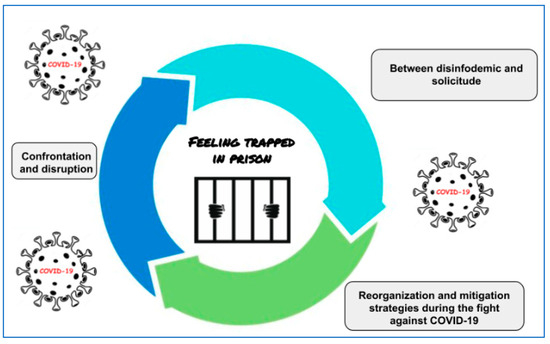







.jpg)

